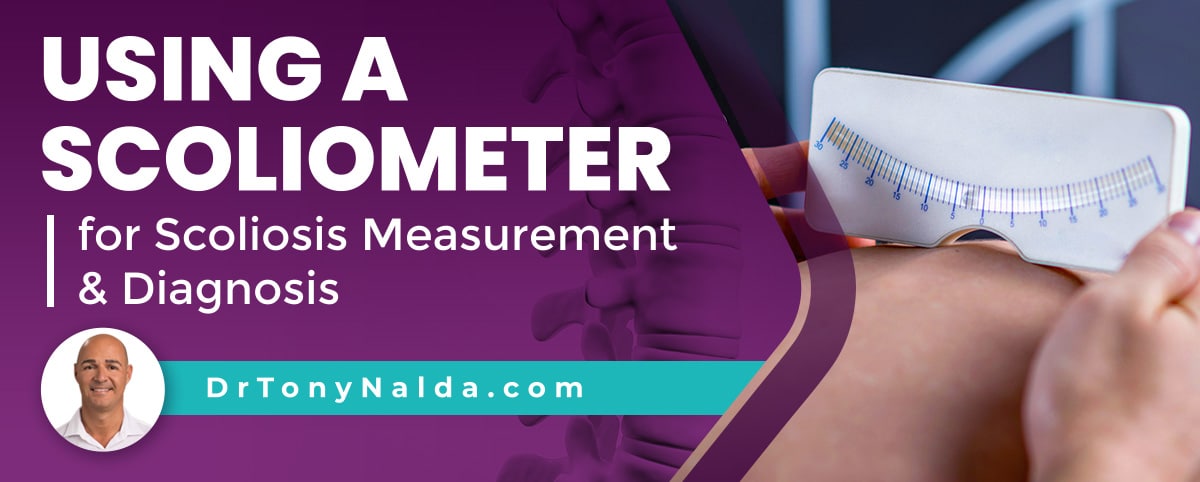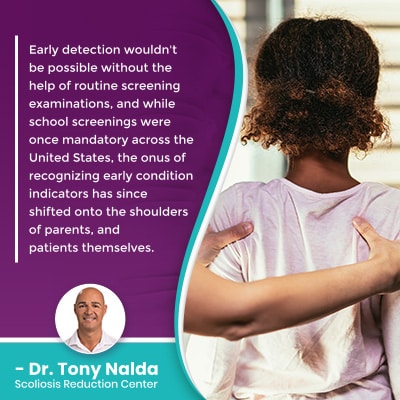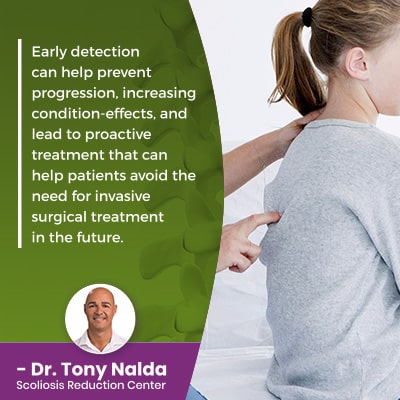Using a Scoliometer for Scoliosis Measurement & Diagnosis

Diagnosing scoliosis isn't always easy, particularly in mild cases when symptoms can be subtle and functional deficits are rare. It's often when mild scoliosis has progressed to moderate scoliosis that people notice symptoms that lead to a diagnosis and treatment.
Scoliosis screening is important because while there are no treatment guarantees, early detection makes treatment success more likely. Known as an Adam's forward bend test, this scoliosis screening exam involves the use of a Scoliometer to determine the degree of vertebral rotation.
Before getting to the specifics of how to use a Scoliometer and what it can tell us, let's first discuss the benefit of early detection.
Table of Contents
Scoliosis is Progressive
Being diagnosed with scoliosis means an unnatural sideways curvature of the spine has developed, and rotation is present, meaning the spine also twists from front to back, back to front, making it a complex 3-dimensional condition.
Scoliosis is also a progressive condition, meaning its nature is to get worse over time, and while this means scoliosis is incurable, it can be highly treatable, particularly when early detection and intervention are achieved.
Scoliosis ranges widely in severity from mild to moderate and severe to very severe, and this is also the condition's progressive line, so where a scoliosis is at the time of diagnosis doesn't mean that's where it will stay, particularly if left untreated, or not treated proactively.
As scoliosis progresses, it gets more complex to treat, and this is because as the size of the unnatural spinal curve increases, the condition's uneven forces also increase, along with their effects.
Scoliosis progression means the scoliotic curve is getting larger, and this increases spinal rigidity and makes the spine less responsive to treatment, in addition to making it difficult for some patients to perform certain therapeutic exercises as part of treatment.
With the Scoliosis Research Society putting current estimates at close to seven million people currently living with scoliosis in the United States alone, the condition is highly prevalent, making awareness important.
With awareness, people can recognize the condition's early signs, and this can lead to early detection, and better treatment results.
 Early detection wouldn't be possible without the help of routine screening examinations, and while school screenings were once mandatory across the United States, the onus of recognizing early condition indicators has since shifted onto the shoulders of parents, and patients themselves.
Early detection wouldn't be possible without the help of routine screening examinations, and while school screenings were once mandatory across the United States, the onus of recognizing early condition indicators has since shifted onto the shoulders of parents, and patients themselves.
The gold standard in scoliosis screening is known as the Adam's forward bend test, and when combined with the use of a scoliometer, it can detect condition indicators that warrant the need for further testing.
Adam's Forward Bend Test
An Adam's forward bend test is a standard screening exam that detects condition indicators that warrant the need for further testing, such as an X-ray to determine a patient's Cobb angle measurement.
The Cobb method is what classifies it as mild, moderate, severe, or very-severe scoliosis, and this is determined by drawing lines from the tops and bottoms of the curve's most-tilted vertebrae; the intersecting lines form an angle that's expressed in degrees.
Also known as a forward bending test, forward bend test, adam's test, and an adam's forward bending test, placing patients in a forward bending position makes the spine, and any related postural asymmetries, highly visible.
As uneven shoulders and hips are often the earliest signs of the condition's most-prevalent type, adolescent idiopathic scoliosis, having patients start in a standing position, then bending forward at the hips at a 90-degree angle, with arms dangling at the sides; in this position, the spine is protruding and highly visible, and the thinner the patient, the more visible the spine will be.
In this position, any related trunk asymmetry is also highly visible; the main sign of scoliosis in children is postural deviation: uneven shoulder blades, uneven shoulders, hips, an uneven waist line, the development of a rib hump, and more.
From an Adams forward bend test, I can see where along the spine the scoliosis is located, if there are any related postural asymmetries, and when combined with the use of a scoliometer, I can learn even more about a patient's spine.
What's a Scoliometer?
A Scoliometer is a scoliosis measurement tool; it's a type of protractor that measures the degree of vertebral rotation and rib arching indicated by the Adam's test.
Scoliometers look like a combination between a ruler and a level, with a notched-out portion in the center, and an internal bubble that moves to indicate the degree of tilt by where it aligns with the numbered side.
While in the forward bend position, the Scoliometer is placed over the spine, at the curve's apex, and as it's moved up and down the length of the spine, the tilt of the vertebrae is measured in degrees.
A Scoliometer helps me detect asymmetry in the back, whether or not a rib hump has developed, and a patient's angle of trunk rotation (ATR); it can also tell me whether or not further testing is warranted.
If a Scoliometer measures more than 7 degrees at a curve's apex, this is considered excessive and indicates the need for further testing such as an X-ray so I can really see what's happening in and around the spine.
Through X-ray imaging, I can determine a patient's Cobb angle and classify their condition as mild, moderate, severe, or very severe scoliosis.
While there is a certain degree of rotation to be expected within the different spinal sections, if there is an excessive amount of rotation, this is abnormal and problematic and can indicate the development of scoliosis.
So let's say a patient has gone for screening, was sent for further testing, and was diagnosed with mild scoliosis? What happens next?
Early Detection and Treatment
Once a person receives a diagnosis of scoliosis, the most important decision to be made is how to treat it moving forward.
Patients diagnosed with mild scoliosis are not going to feel fortunate, but catching the condition early in its progressive line means treatment can be started at a time when there are fewer limits to what can be achieved.
Mild curves are small, flexible, and are going to be the most responsive to treatment; in addition, the body has not yet had time to adjust to the unnatural spinal curve's presence, and as significant progression has not yet occurred, the condition's effects are also mild and subtle.
It's far more effective to proactively work towards preventing progression and increasing condition-effects, than attempting to reverse those effects once they're established, and as a progressive condition, where a scoliosis is at the time of diagnosis isn't indicative of where it will stay.
When there is an unnatural lateral curvature of the spine, once skeletal maturity has been reached, the condition becomes compressive and can be painful; pain is the main symptom of scoliosis in adults.
Early screening and Scoliometer measurements can help achieve early detection, which has a lot of benefits when it comes to treatment efficacy, and when combined with a physical exam and X rays, I can tell a lot about a patient's condition.
 Early detection can help prevent progression, increasing condition-effects, and lead to proactive treatment that can help patients avoid the need for invasive surgical treatment in the future.
Early detection can help prevent progression, increasing condition-effects, and lead to proactive treatment that can help patients avoid the need for invasive surgical treatment in the future.
Conclusion
When it comes to diagnosing scoliosis, certain parameters have to be met; there has to be an unnatural lateral curvature of the spine, with vertebral rotation, and a minimum Cobb angle of 10 degrees.
Early detection of condition types that are at risk for rapid-phase progression, such as adolescent idiopathic scoliosis patients, is particularly important because the constant trigger of growth needs to be counteracted.
An official diagnosis of scoliosis is generally reached through a combination of a physical exam, an Adams forward bend test, combined with the use of a Scoliometer, and X-ray imaging results.
Here at the Scoliosis Reduction Center, I believe in being proactive with treatment by starting it as close to the time of diagnosis as possible because this is when treatment success is the most likely.
When it comes to treating scoliosis in children, achieving a significant curvature reduction and holding it there throughout growth is the focus, and when treating scoliosis in adults, while a curvature reduction is always the goal, the focus is more about stabilizing the spine, pain management, and reducing a curve back to where it was before becoming painful.
If you, or someone you care about, is unsure if scoliosis is an issue, don't hesitate to seek professional medical help; when it comes to progressive conditions, it's far more risky to do nothing than it is to go for early screening that can lead to early detection and treatment success.
Dr. Tony Nalda
DOCTOR OF CHIROPRACTIC
After receiving an undergraduate degree in psychology and his Doctorate of Chiropractic from Life University, Dr. Nalda settled in Celebration, Florida and proceeded to build one of Central Florida’s most successful chiropractic clinics.
His experience with patients suffering from scoliosis, and the confusion and frustration they faced, led him to seek a specialty in scoliosis care. In 2006 he completed his Intensive Care Certification from CLEAR Institute, a leading scoliosis educational and certification center.
About Dr. Tony Nalda
 Ready to explore scoliosis treatment? Contact Us Now
Ready to explore scoliosis treatment? Contact Us Now





